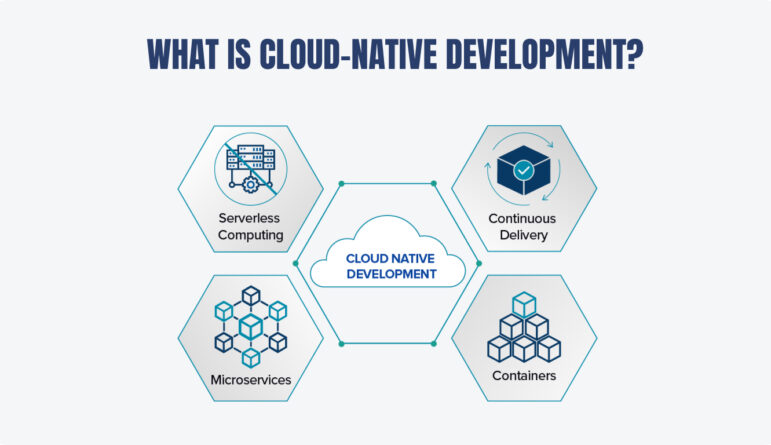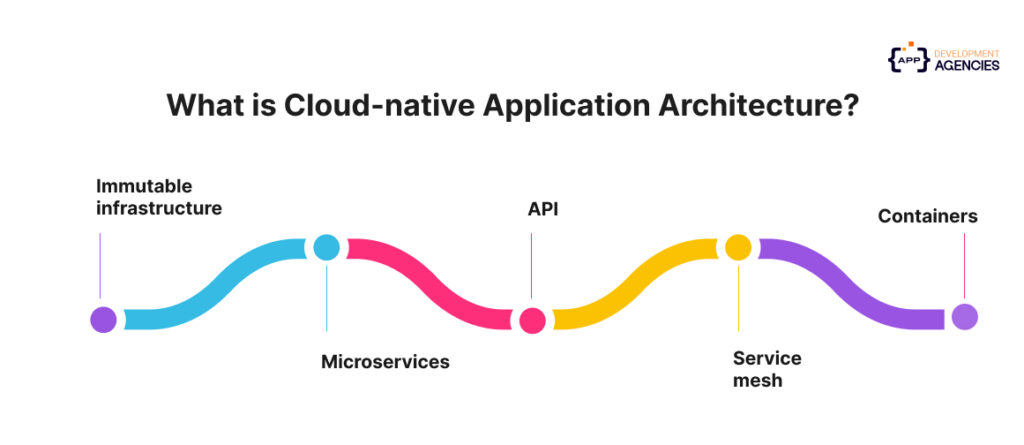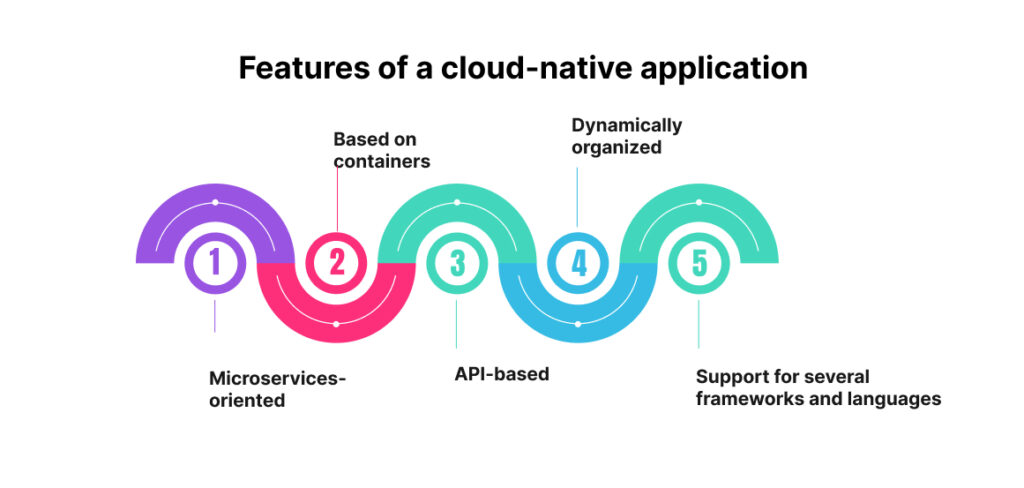
The term “cloud-native” has been popular in software development for a while now. Some developers dismiss it as a trend. For others, it represents the software development of the future. Whatever the future holds, cloud-native will be a major trend. It has also changed how we create, implement, and manage software.
According to Precedence Research’s study, the global market for cloud-native platforms was estimated to be worth $4.6 billion in 2023 and is projected to grow to $52.84 billion by 2033.
Cloud-native app development is a method that highlights the creation and implementation of applications. Whether on a public, private, or hybrid cloud, a genuinely cloud-native application offers a consistent user experience.
This approach to application development equips you for the future as well as the present. Compared to previous approaches, you can create and update apps more rapidly, with better quality, and with lower risk. To help you understand the advantages of this innovation, we will go over the concept of cloud-native development in this blog article.
The software methodology used to develop, implement, and manage contemporary applications in cloud computing settings is called cloud-native. The goal of modern businesses is to create scalable, adaptable, and resilient applications so they can be swiftly updated to satisfy client needs. They achieve this by utilizing contemporary technologies and methods that naturally facilitate cloud-based application development. These cloud-native solutions give adopters a creative, competitive edge by enabling quick and frequent application changes without affecting service performance.
The Cloud Native Computing Foundation (CNCF) is a vendor-neutral organization founded in 2015. It supports open-source initiatives that help with scalable application design, deployment, and management in cloud environments. It also encourages the use and advancement of cloud-native technology.
CNCF encourages cooperation between developers, users, and vendors on microservices, containers, and orchestration technologies like Kubernetes. Its primary objective is to grow a flourishing ecosystem around cloud-native techniques and applications. It offers a range of resources, such as certification and training courses. Amazon is a CNCF member.

The design of services or apps that were created especially to run in the cloud as opposed to a more conventional on-premises infrastructure is known as cloud-native architecture. A successful cloud-native architecture must be self-healing, cost-effective, and simple to maintain by a next-generation cloud. Cloud-native designs are more flexible than legacy systems since they don’t require physical servers.
After deployment, the servers used to host cloud-native apps stay the same thanks to immutable infrastructure. The old server gets disposed of and the application is transferred to a new high-performance server if it needs additional processing power. Immutable infrastructure makes cloud-native deployment predictable by eliminating the need for manual upgrades.
Microservices are discrete, single software elements that work together to build full cloud-native applications. Every microservice concentrates on a single, minor issue. Microservices are autonomous software components that interact with one another because they are loosely connected. Developers work on individual microservices to modify the program. In this manner, even if one microservice fails, the program keeps running.
An application programming interface is a way for two or more software applications to communicate with one another. APIs are used by cloud-native systems to connect the loosely linked microservices. Instead of outlining the procedures to accomplish the result, the API tells you what data the microservice needs and what outcomes it can provide.
The cloud infrastructure’s service mesh is a software layer that controls communication between several microservices. Without adding new code to the application, developers can add more features by using the service mesh.
The smallest computing unit of a cloud-native application is called a container. In cloud-native systems, these software components contain the microservice code and other necessary files. Cloud-native apps operate independently of the underlying hardware and operating system thanks to the containerization of the microservices. Software developers can thus implement cloud-native apps on hybrid clouds, cloud infrastructure, or on-premises. The microservices and their corresponding dependencies, including the resource files, libraries, and scripts needed for the main application to function, are packaged by developers using containers.
How and where developers create and implement cloud-native apps is referred to as cloud-native application development. Cloud-native development requires a culture change. To reduce the software delivery timeframe and provide precise features that satisfy evolving customer expectations, developers implement particular software methods. Below, we provide some typical cloud-native development techniques.
The software technique known as continuous integration (CI) involves developers regularly and error-free integrating changes into a shared code base. Development is more efficient when changes are made often and in small increments since problems may be found and fixed more quickly. Development teams may add new features with more assurance thanks to CI systems. This automatically evaluates the code quality for each change.
One software technique that facilitates cloud-native development is continuous delivery or CD. Development teams can use CD to make sure the microservices are always prepared for cloud deployment. When making modifications, such as adding new features and repairing faults in programs, they use software automation technologies to lower risk. CD and CI collaborate to deliver software effectively.
A software culture known as DevOps enhances the cooperation between development and operations teams. The cloud-native model is consistent with this design philosophy. Organizations can accelerate the software development life cycle by implementing DevOps methods. DevOps tools are used by developers and operation engineers to automate cloud-native development.
In the cloud-native approach of serverless computing, the underlying server architecture is entirely managed by the cloud provider. Because the cloud infrastructure automatically expands and configures to match application requirements, developers employ serverless computing. Only the resources used by the program are paid for by the developers. When the application terminates, the serverless architecture immediately releases its computational resources.

The cloud-native app architecture’s microservices are contained within containers that link and exchange data over application programming interfaces (APIs). All of these elements are managed by orchestration tools.
Following are some of the key features of these applications:
An application can be divided into many separate services, or modules, using microservices. Every service supports a particular business objective and makes use of its data. These modules use APIs to talk to one another.
Software known as containers allows a program to operate independently of physical resources by logically isolating it. Microservices are prevented from interfering with one another using containers. They prevent programs from using up all of the host’s resources. Additionally, they let the same service run in numerous instances.
Microservices and containers are connected by APIs, which also make security and maintenance easier. They provide the link between loosely linked services, allowing microservices to communicate with one another.
Container lifecycles, which can get complicated, are managed with the help of container orchestration technologies. Resource management, load balancing, scheduling restarts following internal failures, and provisioning and deploying containers onto server cluster nodes are all handled by container orchestration technologies.
Developers can select from multiple programming languages and frameworks when creating cloud-native applications. For instance, developers can use Node.js to create an application’s user interface (UI) and MicroProfile to create the Java APIs.
The greatest chances to promote digital transformation and company expansion are provided by cloud-native techniques. Cost-effective native application development makes it possible for continuous integration/continuous delivery (CI/CD) to efficiently update and manage programs. To provide a uniform experience throughout the application development lifecycle, it also assists enterprises in dismantling silos in development, operations, and security.
The following are other advantages of developing cloud-native applications:
The agile development process used to create cloud-native apps enables more rapid iteration and deployment of new features or upgrades because individual services are created and deployed separately.
Because the cloud provider handles the underlying infrastructure, developers can concentrate on adding value to the app when creating cloud-native apps. Additionally, this enhances the operational environment’s dependability and stability.
Cloud-native apps can dynamically add or remove resources in response to demand because they are made to be horizontally scalable. On the other hand, monolithic programs are usually scaled vertically. Cloud-native apps can be quickly deployed, and virtual machines or servers can be added for testing with ease. By maximizing the number of microservices that can run on a host, containers can also save money, time, and resources.
Every microservice can scale on its own according to demand and is logically isolated. The other microservices remain unaffected if one is modified to scale. A cloud-native architecture allows for the possibility that some parts of an application may require faster updates than others.
Because cloud-native application development makes use of segregated microservices, it increases resiliency. A monolithic application’s entire system may crash if one of its components fails. However, cloud-native, fault-tolerant apps are made to keep running even if certain services stop working.
Organizations are not bound to a specific vendor because cloud-native application development transfers microservices between the infrastructures of several suppliers using containers. They can choose the alternatives that are most appropriate for their company by utilizing the services of several cloud providers.
The microservices architecture of cloud-native applications makes it simple to trace problems down to the originating service and resolve them without causing server outages.
Cloud-native apps that use container orchestration services, like Kubernetes, allow enterprises to roll out software updates with little to no downtime.
Some of the fundamental issues with cloud computing are resolved by cloud-native applications. However, there are several obstacles to overcome when moving to the cloud to increase operational efficiency.
The following are some of the main difficulties in developing cloud-native apps:
Finding qualified experts who are knowledgeable about cloud-native applications and related procedures is frequently a challenge for organizations. A large skill pool with knowledge of microservices, containerization, and orchestration technologies is needed to develop cloud-native apps.
Security becomes a major concern because cloud-native apps are spread. As a result, enterprises need to keep aware of potential security risks in the cloud environment and give top priority to integrating thorough security measures.
Cloud-native applications require a complex architecture with many interdependent components, including orchestration tools, microservices, containers, and service management. To guarantee optimum performance and dependability, cloud-native app development necessitates additional preparation in addition to monitoring and maintenance.
Despite the potential cost benefits associated with cloud-native development, enterprises must exercise extra caution for monitoring and managing their cloud computing resources because improper resource allocation or neglecting to address underutilized ones may result in unanticipated costs.
Vendor lock-in may occur if businesses depend too much on particular cloud services or suppliers. If necessary, moving cloud-native apps to different providers may be difficult due to vendor lock-in. Nonetheless, implementing multi-cloud approaches and open standards is a good method to reduce the dangers of vendor lock-in.
Ensuring adherence to industry norms and regulations in a cloud-native setting can be difficult. While retaining the agility that cloud-native apps provide, organizations must manage a variety of compliance standards.
The future of software development is expected to be cloud-native applications, which have become more popular in recent years. Cloud-native apps are set to undergo a dramatic change in the future, characterized by greater integration of AI and machine learning with cutting-edge technologies like green cloud and quantum computing.
Furthermore, cloud-native applications will keep having improved security features built into CI/CD pipelines, with a greater emphasis on scalability and flexibility in multi-cloud settings.
When developing cloud-native applications, a “not invented here” mindset has no place. The services that developers employ to produce features that people love are an expression of creativity. That alone is a reward.
Cloud-native is a strategic edge that may maximize your use of the public cloud and provide your clients with greater value. You can move from traditional deployment strategies to cloud-native applications to increase speed, reliability, and scalability. The future lies in cloud-native applications.
We hope that you now understand this strategy better and know how to begin the process of implementing it.
2 Comments